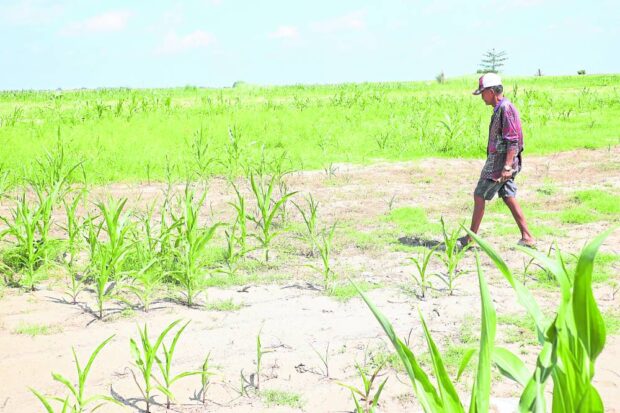Water levels in Luzon dams keep dropping

STUNTED | Ricarte Nicolas checks on his corn plantation in the City of Ilagan, Isabela province, on Wednesday, as his crops start showing signs of stunting due to lack of rainfall in recent weeks.
With the onset of the El Niño phenomenon, water levels in major dams in Luzon, including Magat in Isabela, have started to drop, reducing irrigation supply to farms. (Photo by VILLAMOR VISAYA JR. / Inquirer Northern Luzon)
RAMON, Isabela, Philippines — Water levels at Magat Dam in Isabela province and Angat Dam in Bulacan province continue to drop to almost their critical levels as the dry spell brought about by the El Niño phenomenon persists.
On Wednesday, Magat Dam’s water level registered 162.89 meters, slightly above its 160-meter critical level and the lowest level recorded at the reservoir in this town this year. Magat’s lowest water level on record was 149 meters in July 1991.
Water inflow was recorded at 24.19 cubic meters per second (cms) and outflow at 147.22 cms, said Carlo Ablan, National Irrigation Administration-Magat River Integrated Irrigation System (NIA-MARIIS) division manager, in an interview on Wednesday.
In Bulacan, water level at Angat Dam, the main source of water for Metro Manila households and businesses and for farms in Bulacan and Pampanga provinces, had dropped to 178.14 meters on Wednesday, which was almost 2 meters lower than the 180-meter minimum operating level. Its elevation on Tuesday was 178.76 meters, 179.19 meters on Monday and 179.54 on Sunday.
Rotational release
As a remedial measure, Magat Dam, which supplies irrigation to 88,000 hectares (ha) of palay farms, reduced its rotational water release from 150 cms to 112 cms this month, according to an advisory issued by Roldan Bermudez, NIA-MARIIS engineering and operations division acting manager, on Wednesday.
Supply for upstream farms will be limited for three days while downstream farms will also be irrigated for three days each week.
If the lack of rainfall persists in the coming weeks and the Magat reservoir hit its critical level, the dam would likely be unable to irrigate its service areas in three towns in Quirino province and in Cordon town and Santiago City in Isabela. The 11,000-ha area being serviced by the Baligatan diversion dam will also be affected.
Lack of irrigation water supply from Magat increases farm expenses as farmers turn to water pumps, according to farmer Simeon Danao of Gamu, Isabela.
“This is an additional expense. Why can’t the government provide solar-powered pumps and more subsidies to farmers? We are losing money,” Danao said.

HANGOUT SPOT | Students on a break relax by Angat Dam at Barangay San Lorenzo in Norzagaray, Bulacan, on Monday, July 10, 2023, unmindful of the receding water level at the reservoir. Angat’s water level on Wednesday dropped to 178.14 meters, below the 180-meter minimum operating level. (Photo by LYN RILLON / Philippine Daily Inquirer)
Gov’t help sought
Palay farmer Lucito Preza of Barangay Lenzon, also in Gamu, rued the lack of priority of the government on irrigation expansion.
“We are so sad to hear the news. The government prioritizes agricultural commodities for Metro Manila but not [the need] for irrigation of farmers in the provinces,” Preza said.
According to Narciso Edillo, Department of Agriculture regional executive director in Cagayan Valley, the government had been monitoring the impact of the El Niño weather phenomenon in places like Isabela and other provinces in Cagayan Valley as these areas are major sources of crops like rice.
But Edillo said the government was discussing the distribution of water pumps and seed subsidies and the conduct of cloud-seeding operations to help farmers in the region.
Carlos Dimaapi, a farmer leader in Plaridel, Bulacan, said rice farmers on their second cropping season had no choice but to rely on the reduced supply from Angat Dam, now down to 28 cms from the 36 cms regular allocation from the National Water Resources Board (NWRB).
The NWRB reduced the allocation for the irrigation needs of the farmers to prioritize the water requirement of Metro Manila households and businesses.
Dimaapi said their farms could still tap stock water in irrigation canals, which were collected from previous rains in Bulacan, except those in the Sierra Madre ranges in the uphill areas of Norzagaray town.
Francis Clara, head of the Water Control and Coordinating Unit of NIA, said water in the 26-kilometer stretch of irrigation canals from Angat Dam to Bustos Dam, which the agency released on June 16 or a day after farmers started planting, would still be enough to supply farms during the second cropping season.
More than 20,000 farmers, tilling around 27,000 ha in four towns in Pampanga and 16 towns in Bulacan, depend on Angat Dam for their irrigation needs.
Clara said the 28 cms allocation for irrigation will continue until July 30. The NWRB has yet to announce the allocation for farmers for August and September before the harvest period in October.